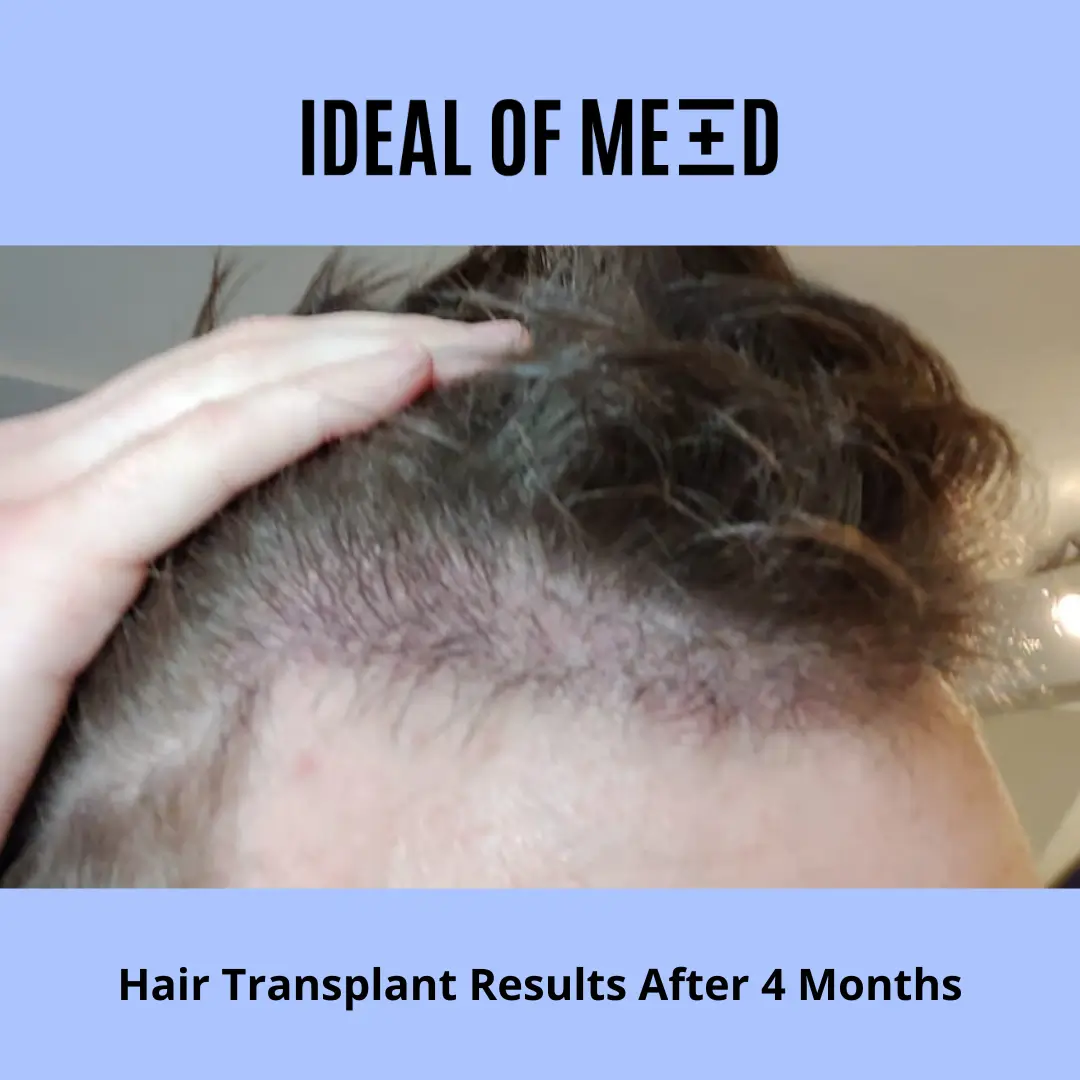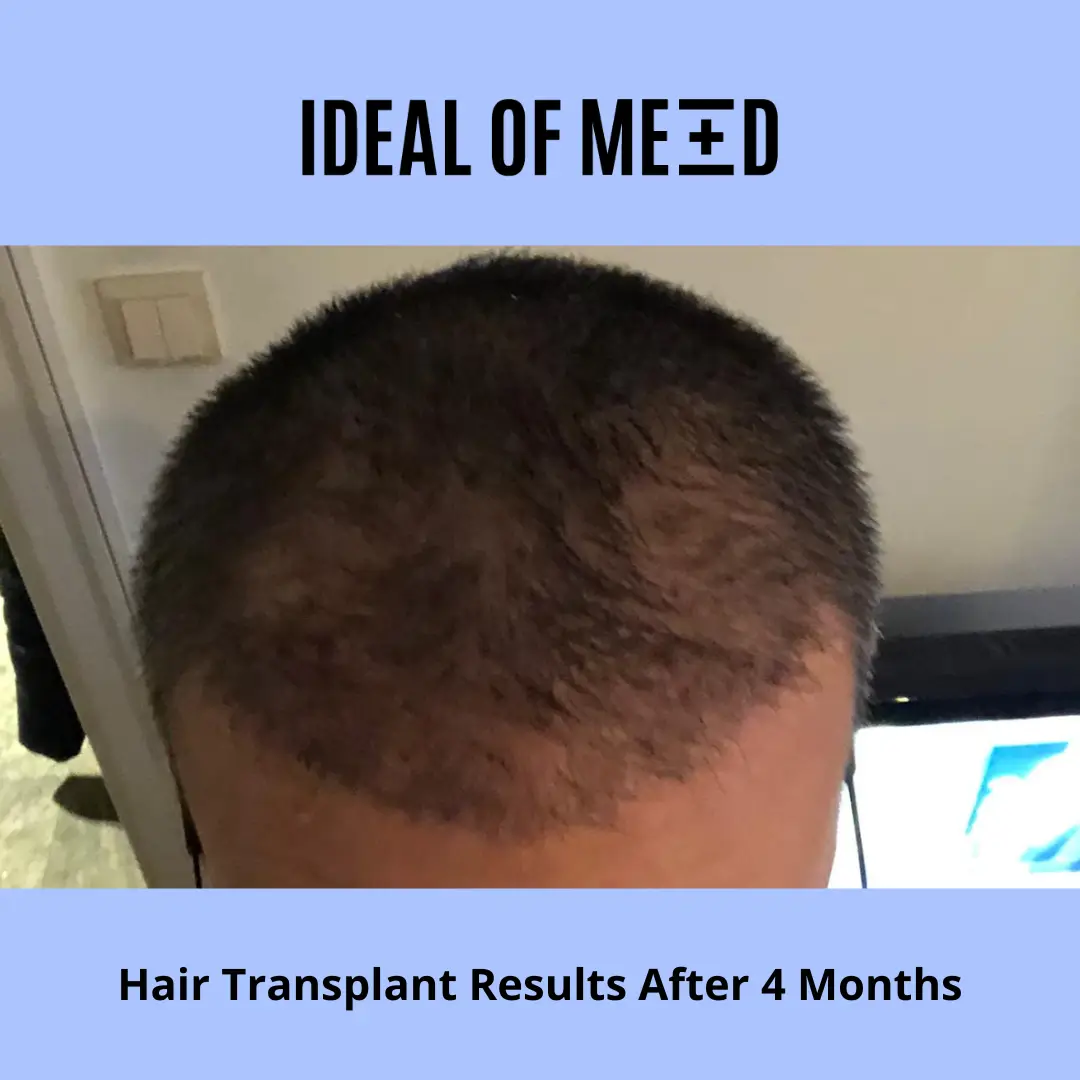Hair Transplant Results After 4 Months
Previously we covered what you can expect after 1 month, 2 months and 3 months. In order to know what to expect prior to surgery, we’ll now go through what to anticipate four months after a hair transplant treatment.
Table of Contents
Hair Transplant Results After 4 Months Photos



Hair Transplant Results After 4 Months | What You Should Know
The implanted hairs will naturally shed throughout the first three months after surgery. So what can you anticipate seeing in the mirror four months following a hair transplant?
You should have started to see fresh hair growth after 4 months. Initially appearing as fine hair, it gradually thickens over time. These new hairs are still in their infancy, and it will be more than eight months before you see the ultimate results of your hair transplant. At the four-month stage following a hair transplant, around 10% to 20% of the transplanted hair follicles are actively growing at the rate of about one centimetre a month.
If the recipient region still has a patchy appearance and the new hairs are weak and almost transparent in appearance, don’t be worried. Your hair will take a few more months to grow longer, stronger, and more closely resemble your natural hair colour. Additionally, implanted follicles under the skin that are taking a little longer to begin growing again after the shedding phase will produce greater growth.
Hair Transplant Growth After 4 Months
Various factors influence the growth rates of follicles. A key aspect of the hair transplant procedure is the method used and the location where the follicle will be implanted. The frontal area, for example, contains several arteries and blood vessels that nourish hair, so it’s common for hair follicles to grow faster here than in the head.
Do not become alarmed if, after four months, you have not noticed any new hair growth. Following a hair transplant, the new hair develops differently for each person.
Your new hair might start to grow in anywhere from three to six months. The duration of your hair’s resting (telogen) phase will determine this. After your old hair has fallen out, the newly created hairs at the follicles will begin to grow through your scalp.
Can You Speed Up Hair Growth In The Crown?
In the event that your hair doesn’t grow as fast as you would like, remember – patience is the key, but you can also speed up your hair growth by following these methods.
While progress might seem slow, at month 4 you are not far away from seeing hair growth. From month 6, you will often notice a significant growth spurt, as your hair gets not only longer but stronger and thicker too. Once you reach a year to 12-18 months since your hair transplant, you can expect to see the final result.
Important information to remember following a Hair Transplant Results After 4 Months to speed hair growth;
- A balanced diet that includes both protein and carbs can promote hair development. Meat and egg products include biotin, which is necessary for the synthesis of the protein keratin, which is present in hair.
- Your scalp will have healed enough after two weeks that you may get a gentle head massage with oils for hydration and nutrition.
- Follow your doctor’s advice about taking medications such as minoxidil, finasteride, and multivitamins.
- Consider using shampoos or supplements that may help to strengthen the hair follicles, such as biotin pills and argan oil shampoo. These products and more are part of your IdealofMeD package.
It takes time to restore your hair, so don’t expect to see results right away. It’s crucial to accept the recommendations of your committed care team to speed up the healing process and encourage the growth of new hair.
Treatments Available
Mesotherapy and hyperbaric oxygen therapy are the two possible therapies that will have an impact on your hair transplant after 4 months. Since both treatments would provide optimum hair transplant results after 4 months, they are both safe and recommended.
- Mesotherapy: Mesotherapy is a procedure that enables the replacement of the vitamins, minerals, and amino acids that were lost during the hair transplant operation.
- Hyperbaric Oxygen Therapy or HBOT: It enables the body to receive more oxygen, which helps with recuperation and the likelihood that the operation will be successful.
Hair Transplant Side Effects
You can still have negative effects from a hair transplant at around month four, including an itchy scalp. Avoid rubbing or scratching an itchy scalp as this might make the discomfort worse. You could discover that taking an antihistamine or using aloe vera gel on the affected region might help reduce the itching.
Notify your clinic if you’re still experiencing itching issues so that your surgeon can offer appropriate advice.
Variables That Could Affect Your Hair Transplant Results After 4 Months
It is normal for your transplant hair to shed following surgery. Follicles that are transplanted enter a resting phase known as telogen, which is part of the hair growth cycle. This telogen phase lasts around three months, during which the hairs become disconnected from the hair follicles and are at rest, which explains why you don’t see hair growth until four months. During the telogen period, your hair follicles are producing new hair.
The final outcomes hinge on a number of variables. Several elements can influence how well a hair transplant works, including;
- The ratio of donor area to recipient area will depend on the severity of the hair loss.
- Patients with a light complexion and dark hair will have the appearance of thinner hair because more skin will be seen through the hair.
- Naturally, thick, curly hair will look thicker than fine, straight hair.
- The number of follicular units will be more abundant in patients with thick hair in the donor location.
- Donor follicular unit groupings – A donor whose hair is mostly made up of one and two hair follicular units appears ‘thicker’ than a donor whose is mostly made up of three and four hair follicular units.
Observing Your Hair Growth After a Hair Transplant
The negative effects of the hair transplant, such as swelling, redness, irritation, and itching, may also go away after four months. Mild hair growth may also begin to appear. Hair loss is a possibility and a natural component of the hair growth cycle. Rarely, hair loss may not occur, which is a positive indicator. One should keep in mind that it takes a year for hair to grow with the FUE and DHI techniques.
At IdealofMeD, doctors use the FUE and DHI techniques, as well as a combination of the FUE Sapphire and DHI methods, to restore hair loss. They also use the Ice method to preserve the hair follicles during the preserving stage of the hair transplant. This method has shown significant improvements in the success of hair transplantation.
Others Also Read
- Hair Transplant Results After 1 Month
- Hair Transplant Results After 2 Months
- Hair Transplant Results After 3 Months
- Hair Transplant Results After 5 Months
- Hair Transplant Results After 6 Months

Frequently Asked Questions
The hair follicles undergo a resting period when the hair falls out, following the first healing cycle. For the majority, regrowth starts three to four months later. Up until the final outcome is attained, additional hair grows and develops during the next twelve to eighteen months. When dealing with scars or damaged skin, repair patients may see a difference in turnaround times.
Every patient recovers at a different rate, so you might just need a bit more time for the healing to be complete. Your natural hair cycle may be a little longer than the typical person’s and require a little more time to transition back to the growth phase. Continue with your post-hair restoration surgery treatments and maintenance, and you should see a change within a few weeks.
Will there be communication Following the hair transplant procedure, IdealofMeD professionals will get in touch with you once every one or two months to make sure that your healing and recuperation are proceeding as planned and to address any questions or concerns you may have. Additionally, they will provide you with treatment recommendations and go over the next stage of your rehabilitation with you.

Jo
Last updated by Jo on September 8, 2022. Content medically reviewed by D. Demirel, MD.
- Rajput, R.J., 2008, November. Cyclical Medicine for hair loss management and improved results in hair transplantation. In Hair Transplant Forum Int (Vol. 18, No. 6, pp. 208-10).
- Garg, S., 2016. Outcome of intra-operative injected platelet-rich plasma therapy during follicular unit extraction hair transplant: a prospective randomised study in forty patients. Journal of Cutaneous and Aesthetic Surgery, 9(3), p.157.
- Zito, P.M. and Raggio, B.S., 2019. Hair transplantation.
